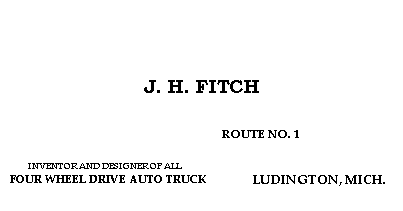The Four Drive Tractor
The Story of how John H. Fitch invented the Four Drive Tractor
While farming, John Fitch would watch automobiles pass over the roads bordering his fields in Riverton Township, Mason County, Michigan. Occasionally, one would get stuck with the two back wheels spinning to no avail while the front ones were standing still helpless. John would then help the motorist out with his horses.
Around 1910, he began to think about a machine that would give power to the front wheels as well as the rear axle. He mused over his ideas, put them together and started to build his four-wheel drive machine in the form of a tractor in his barn. John's friends gave him dubious encouragement while others scoffed at the idea. He assured them that the first time he ran his machine, he would take it right up to the top of the highest hill on his farm.

The first machine was made by taking the drive ends from two ordinary two-wheel drive tractors and connecting them together with the motor in the center between the two. This was a good start, but he had a good deal of trouble in arranging the machine so that it would steer. He finally accomplished this by utilizing the old, well-known fifth wheel and live king bolt idea.
In 1914, John sold a patent for his ratchet wrench that he invented for $5,000 to finish the tractor. On February 2, 1914, he took out nine patents for his invention which was granted on October 20, 1914. One day after he completed assembly, he put gasoline into the tank, started the engine and headed for the foot of the highest hill on his farm. All four wheels took hold and the machine started walking right up the grade as if it were a level stretch. Neighbors around the countryside watched John as he sat at the wheel and moving up the slope. When he reached the top, they waved their handkerchiefs and gave him lusty cheers. He had fulfilled his promise! The next day, he drove the tractor seven miles into Ludington.

After the use of this machine and its observation by others, John was induced to further perfect this extraordinary machine and put it on the market in a commercial way. He built both a tractor and a truck model and took them both to Detroit in February and March of 1915 to show off his inventions and to discuss their possible manufacture. A number of automobile experts pronounced the truck as one of the most important automobile inventions of the past year. The model was extremely simple and could be manufactured more cheaply than the trucks of that time.
The tractor had many features that were not on previous tractor models. Its short turning radius, improved suspension, trailer/plow attachment and two speeds were other items besides the four-wheel drive that made this an important improvement to farming. The tractor could go into difficult places where conventional tractors could not. It could come out of a ditch as well as break through snow drifts. There was no danger of getting stuck in sand or clay - the lightness of the machine and its equal distribution of weight prevented it from sinking into the ground to any appreciable distance. Although light in weight, its power enabled it to pull a very heavy farm tool. The increased power came from the fact that the tractor was gear-driven vice chain-driven like the tractors of that time. This allowed for more transfer of power from the engine to the wheels.
To show off its ability, John would drive up to an eighteen-inch curb, large blocks of wood or large stumps and the tractor would climb over the obstacles with no problems. There are reports of him climbing up a strong wall of his barn and standing the tractor on its back wheels! The tractor could only do these stunts because of the great pulling power possessed by the front wheels, the arrangement of the steering gear, the use of gears instead of chains, and the three-point suspension of the frame upon the axles. This particular device constituted one of the most important features of the machine and John had it protected by nine patents, of which eight were basic.

Men from all over the country claimed that the tractor held very first-rate and there was not another machine on the market that could equal it. It was estimated that the tractor could easily do the work of nine or twelve horses in practically any type of terrain. One particular demonstration took place on marshy land at Pentwater, Michigan. While critics said it would bury itself as a team of horses would do in such ground, the tractor not only pulled itself out of the marsh but it pulled up a submerged tree trunk to which it had been fastened! At seeing this, Carlton E. Logan of Quenemo, Kansas tossed his hat in the air and acclaimed it the best tractors that he had ever seen.
On November 29, 1915, John organized and incorporated ‘The Four-Drive Tractor Company’.

John's truck was not the first four-wheel drive truck to be invented. The Four Wheel Drive (FWD) Auto Company (initially known as "Badger") of Clintonville, WI produced the first American built FWD trucks in 1911. [return]
The Heer Engine Company of Ohio and the Canadian Heer Engine Company of Winnipeg produced a four-wheel drive gasoline tractor as early as 1909. Others included the 1912 Olmstead Four Wheel Pull and 1912 Nelson Four Wheel Drive. [return]

